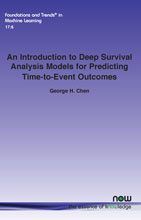An Introduction to Deep Survival Analysis Models for Predicting Time-to-Event Outcomes
By George H. Chen, Carnegie Mellon University, USA, georgechen@cmu.edu
Abstract
Many applications involve reasoning about time durations before a critical event happens—also called time-to-event outcomes. When will a customer cancel a subscription, a coma patient wake up, or a convicted criminal reoffend? Accurate predictions of such time durations could help downstream decision-making tasks. A key challenge is censoring: commonly, when we collect training data, we do not get to observe the time-to-event outcome for every data point. For example, a coma patient has not woken up yet, so we do not know the patient’s time until awakening. However, these data points should not be excluded from analysis as they could have characteristics that explain why they have yet to or might never experience the event.
Time-to-event outcomes have been studied extensively within the field of survival analysis primarily by the statistical, medical, and reliability engineering communities, with textbooks already available in the 1970s and ’80s. Recently, the machine learning community has made significant methodological advances in survival analysis that take advantage of the representation learning ability of deep neural networks. At this point, there is a proliferation of deep survival analysis models. How do these models work? Why? What are the overarching principles in how these models are generally developed? How are different models related?
This monograph aims to provide a reasonably self-contained modern introduction to survival analysis. We focus on predicting time-to-event outcomes at the individual data point level with the help of neural networks. Our goal is to provide the reader with a working understanding of precisely what the basic time-to-event prediction problem is, how it differs from standard regression and classification, and how key “design patterns” have been used time after time to derive new time-to-event prediction models, from classical methods like the Cox proportional hazards model to modern deep learning approaches such as deep kernel Kaplan-Meier estimators and neural ordinary differential equation models. We further delve into two extensions of the basic time-toevent prediction setup: predicting which of several critical events will happen first along with the time until this earliest event happens (the competing risks setting), and predicting time-to-event outcomes given a time series that grows in length over time (the dynamic setting). We conclude with a discussion of a variety of topics such as fairness, causal reasoning, interpretability, and statistical guarantees.
Our monograph comes with an accompanying code repository that implements every model and evaluation metric that we cover in detail: https://github.com/georgehc/survival-intro.
An Introduction to Deep Survival Analysis Models for Predicting Time-to-Event Outcomes
The earliest research into time-to-event outcomes can be dated back to the 17th century. Here the initial focus was predicting time until death, hence the term survival analysis. Applications of time-to-event outcomes are to be found in many walks of life, such as insurance, medicine, and even calculating when will a customer end their subscription. Recently, the machine learning community has made significant methodological advances in survival analysis that take advantage of the representation learning ability of deep neural networks. At this point, there is a proliferation of deep survival analysis models.
In this monograph, the author provides a self-contained modern introduction to survival analysis. The focus is on predicting time-to-event outcomes at the individual data point level with the help of neural networks. They provide the reader with a working understanding of precisely what the basic time-to-event prediction problem is, how it differs from standard regression and classification, and how key “design patterns” have been used time after time to derive new time-to-event prediction models.
The author also details two extensions of the basic time-to-event prediction setup, namely the competing risks setting and the dynamic setting. The monograph concludes with a discussion of a variety of topics such as fairness, causal reasoning, interpretability, and statistical guarantees.
This timely monograph provides researchers and students with a succinct introduction to the use of time-to-event outcomes in modern artificial intelligence driven systems.
